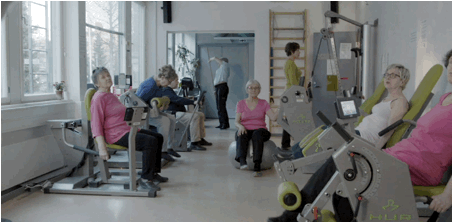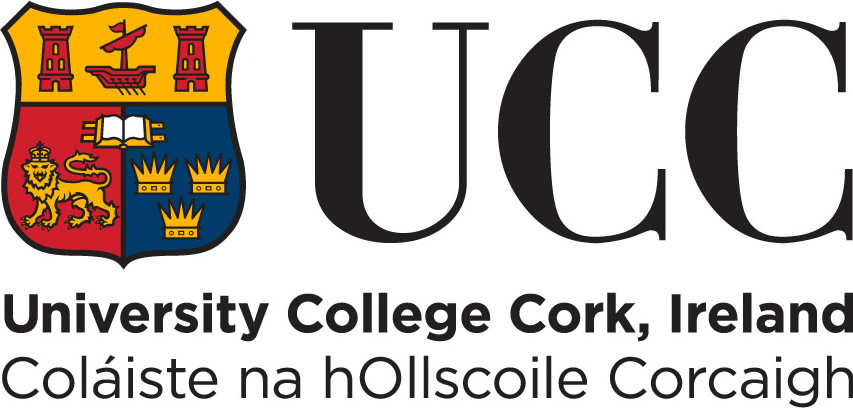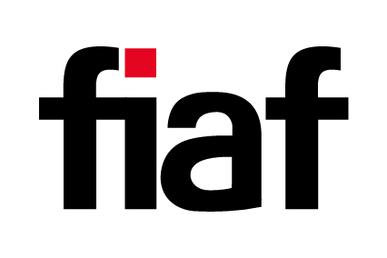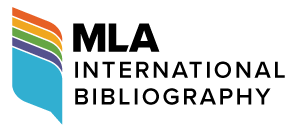Encountering the Invisible
Susanna Helke
What are potential methods of representing the invisible complexities of present-day societal reality through creative documentary film? How can the abstract core of phenomena such as the neoliberal paradigm shift in the welfare state be made visible? What are the possibilities of documentary film practice as a reflexive and critical endeavour beyond the models and modes of film narratives stemming from the emotion economy of the hegemonic film industries, which are increasingly dominating documentary film production culture? The power of the arts is in creating ruptures in the ways the pre-existing order of commonsensical reality is experienced, but how can reality material–based art, such as documentary film, employ strategies which reach beyond the constraints of realism? What is the place of absurdity and laughter within the conventions of documentary film, which is seen primarily as a discourse of sobriety?
Understanding praxis as a key element in artistic research relates to Henk Borgdorff’s positioning of works of art as a context, method, content and an outcome of artistic research practice (144). Similarly, Mika Suoranta, Juha Hannula and Tere Vadén define artistic research as a self-reflective and self-critical process, in which an artist is taking part in the production of meaning within contemporary art (10). Artistic research and research in the artsare amethodological framework which emphasises theorising within and through praxis. This happens in the theory–praxis–poetics triangle, and the process primarily aims at catalysing new methods, modes and approaches in filmmaking. Understanding artistic research or research in the arts as a catalytic process, in which the essential outcome is embodied in an artwork, relates to the work of early cinema’s filmmaker theorists from the beginning of the twentieth century. Sergei Eisenstein formed an array of theories of cinema, for example, his montage theory was formulated both by making and by writing (72–83). The films embody this theory as praxis, which was developed through his theoretical writing, employing a rich compilation of multidisciplinary insights, illuminating the path of Eisenstein’s thinking on cinema which culminated in praxis: creating poetics for the still emerging artform through theorising within the materiality of cinema. The core raison d’être of artistic research or research in art was present in the work of the early filmmaker/theorists and many other maker/theorists during the history of various art forms. For example, Bertolt Brecht’s work in the context of theatre can be seen as a predecessor of the theorising-within-artpraxis, a maker’s formulation and manifestation of the particularities of his theatre poetics. Maker’s theory is not theory on art but theory within art, rethinking praxis in order to catalyse new poetics. In the present moment of history, when we cannot enter the endeavour of theorising within cinema at its inception, an unavoidable element is re-evaluating praxis as it is defined by the conventions that stem from the tradition. Praxis can be seen as a set of conventions, forms, norms and traditions that are institutionally constructed by the community of practitioners.
I contextualise my practice within the tradition of documentary film. In many of my films, e.g. American Vagabond (2013), Playground (2010) and The Idle Ones (2001), elements deriving from the conventions of social documentary can be recognised. The ethos of “social documentary” was defined by the work of early photographers such as Jacob A. Riis and Lewis Hine, who worked at the beginning of the 1900s. This ethos still informs the production formulas of mainstream social documentary. The work of these early photographers aimed at societal change; the photographs as artefacts were primarily instruments of visual evidence of certain societal defects rather than aesthetic ones (Helke 184). The agenda of change and the instrumental quality of the medium were encapsulated in their enterprise. Nevertheless, the conception of reality-based cinema as an instrumental apparatus, as a mere tool to advance the filmmaker’s societal agenda is a problematic one.
Presently I am leading an artistic research project called Images of Harmony and Rupture: Documentary Film Reflecting Fractures in the Scandinavian Welfare State Ethos at Aalto University Film, Television and Scenography Department. This project intends, through theorising, filmmaking, and colliding theory with praxis, to catalyse new approaches and methods of revealing the paradigm shift in the Finnish welfare state and making visible the ways the commitment to the Scandinavian welfare-society ethos is unravelling.
While the societal tensions and the exclusion of the underprivileged may not be as dramatic as they were when the ethos of “social documentary” was defined, we as documentary filmmakers are facing a challenge. How can the abstract and hidden ways in which neoliberal rhetoric and the ever-increasing emphasis on techno-economical paradigms, for instance, be cinematically expressed and represented? The expected unravelling of the welfare-state ethos does not necessarily manifest itself in a pronounced and immediate eradicating of the societal structures of the welfare-state model, but something is dramatically changing in hidden and concealed ways.
The documentary film tradition mostly relies on the serious and solemn, but could absurdism and parody more accurately capture the complexities of the present crises we are experiencing? The film I am presently working on aims at portraying the privatisation of the elderly care sector in Finland. Wicked Stuff (working title) is a film employing the tone of satire and black humour in order to reveal the underlying clash between econo-political rhetoric, the logic of profit and ethos of caring, as well as the claim of the superiority of privatisation over publicly funded services. All the material in the film is reality based: the material from the ongoing political debates in parliament, quotes from the news media, real-life political debacles, and the rhetoric celebrating the “Freedoms of the Market” and “Promises of Privatisation”, as well as the real life experiences of care workers working with the elderly, are turned into the lyrics of playful, composed choir pieces which employ the tradition of political couplet songs. The images consist of ordinary people singing these songs in various settings of actual work places. The staged scenes are juxtaposed with vérité-style documentary scenes anchoring the material in real-life experiences. At its core, the film is a portrayal of the changing landscape of ethics in an era in which individuality and self-interest is replacing the shared nature of our societal coexisting/coexistance.

Figure 1: Work-in-progress documentary film Wicked Stuff (working title), 80 mins.
Dir. Susanna Helke. Production Roadmovies LTD.
Wicked Stuff aims at creating, using cinematic means, an agonistic space for a dialogue concerning the paradigms upon which our society is built. I refer to Chantal Mouffe and Ernesto Laclau’s notion of agonistic pluralism as a fundamental constituent of democratic apparatus (Mouffe 745–758; Mouffe and Laclau 4). The political remains political only when existing disagreements on the fundamentals behind political decisions are not concealed as mere value-neutral technocratic procedures. By creating a space of collisions for the very language used in political rhetoric, the film seeks to induce a shared experience of laughter, pursuing the empowerment of counterhegemonic discourse and the recognition of neoliberal rhetoric not as value-neutral but rather as intentionally designed tactics to enforce specific objectives.
The film employs a satirical tone and black humour as deliberate strategies of defamiliarisation. The econo-technocratic—and neoliberal—paradigm has become disguised and rendered ethereal by the persistent presence of political rhetoric normalising it in the mainstream media. Trying to grasp the essence of this change with a realism-based journalistic approach using a documentary reportage style would remain inadequate. The way publicly funded services have been debated in the political news media has concealed the ideological ambitions and desires of the political rhetoric, normalising the political aims as pure technical proceedings aiming at saving the budgetary future of the nation. Repeating the narrative as a realist representation would not necessarily reveal the rhetorical operations lurking behind the political debates but rather further normalise them as politics as usual. By employing absurdist strategies and provoking laughter, the film aims to look beyond the normalcy of everyday rhetorical political neologisms such as the “sustainability gap” or “uncontrolled expansion” of the public sector. Laughter and black humour are strategies to make everyday political reality and econo-tehnocratic lingo look unfamiliar and strange, laughable and comical in relation to the fact that the healthcare system touches upon the immeasurable core values of human life.
The documentary film theorist Bill Nichols defines the documentary genre as “discourse sobriety”, and this notion of the convention is elementary when reflecting upon its relation to strategies such as satire or comical(3). The documentary tradition incorporates—especially when representing societal reality—the agenda of change, instrumental aims and the discourse of sobriety. Grave societal matters ought to be dealt with in a sober and earnest manner. Even though there are some well-known examples of political satires in the history of documentary film, these strategies are not prevalent in dealing with societal or political matters within the genre. Since the beginning of the 2000s, the emergence of hybrid strategies in the contemporary Scandinavian creative documentary has inspired films in which serious political content has been dealt with through the use of satirical play, often blurring the boundaries between fiction and documentary. Mads Brügger, a Danish filmmaker and journalist, made the film The Ambassador (2011), in which he pretends to be a Liberian ambassador and a businessman attempting to build a match factory in the Central African Republic. Through his camouflage identity, he manages to enter the grim reality of corruption, deeply rooted in the society, and to reveal the involvement of Western diplomats in the crude and neocolonial business of the black-market diamond trade. Regardless of the grave topic and the barefaced danger to which the filmmaker exposes himself and his whole team, the tone of the film is carnivalesque. Brügger uses himself as an agent through whose performance the spectator can see underneath the surface of the relation of diplomatic apparatus and African political power. His character is the embodiment of Western ignorance and indifferent greed, and we as spectators, instead of experiencing the obsolete misrepresentations of African nations as inherently chaotic and incapable of democratising their societies, are made to tear into pieces the image of ourselves as outsiders by laughter and absurdist strategies.
Wicked Stuff will have a central protagonist who ties the different elements together and creates a gaze and tone through which the spectator is expected to experience the film: Sepi Kumpulainen, an anti-hero character from the Finnish pop scene of the 1990s. Sepi was a developmentally challenged young man working as a janitor in Helsinki, singing simple three-chord tunes accompanied with a guitar. One of his songs—“Armotonta menoa” (“Wicked Stuff”)—became a huge hit and simultaneously a quintessential song capturing the spirit of the era. Today he still tours around Finland as part of a duo, singing couplet songs that comment on everyday reality from the perspective of those who have been disenfranchised by society—and also on the ongoing debates on the political decisions that, from the perspective of the ordinary citizen, seems to be a chaotic political mess. His character is a metaphorical reincarnation from another era. While textbook crisis rhetoric is being used in political speeches addressing the citizens, the actual economic crisis of the 2010s has never reached the proportions of that of the 1990s. In the film, the simple and naive songs by Sepi Kumpulainen grow into rich and elevated choir pieces composed by Anna-Mari Kähärä. Nevertheless, he is not represented in the role of the indispensable “noble poor”. The “victim motif” is one of the most pertinent characteristics of the genre, employed since the early phases of the social documentary project, augmenting the filmmaker’s agenda of change by storylines in which societal conflicts are made visible by the victim narratives of those who suffer within the depicted circumstances (Winston 47). Instead, Kumpulainen’s character makes us laugh with him at the cynical econo-political rhetoric in the era of post-reality.
Jacque Rancière’s notion of the “distribution of the sensible” illuminates, rudimentarily, the idea of how political and societally experienced realities are constituted. In Rancière’s thinking, the political, apart from “le police”, consists of those rare moments in which ruptures occur in the ways political reality is sensed and made sense of, disrupting the commonsensical order by redistributing the established demarcations of the sensible. Art can go beyond the agreements regarding what is considered to be a legitimate subject or language of societal or political conversation, on defining the borders of what can be made visible, what is marginalised and what is accepted as the naturalised hegemonic order of social reality (Rancière, Politics of Aesthetics 3, 12). For Rancière, “Politics occurs wherever a community with the capacity to argue and to make metaphors is likely, at any time and through anyone's intervention, to crop up” (Disagreement 60).
Laughter is the ultimate rupture, capable of revealing the nakedness of the Emperors of our time.
References
1. The Ambassador. Directed by Mads Brügger, Zentropa, 2011.
2. American Vagabond. Directed by Susanna Helke, For Real Productions, 2013.
3. Borgdorff, Henk. The Conflict of the Faculties: Perspectives on Artistic Research and Academia, Leiden UP, 2012, DOI: https://doi.org/10.26530/OAPEN_595042.
4. Eisenstein, Sergei. Film Form. Essays in Film Theory. Translated by Jay Leyda, Harcourt Inc., 1977.
5. Hannula, Mika, Juha Suoranta, and Tere Vadén. Artistic Research Methodology: Narrative, Power and the Public. Peter Lang, 2014, DOI: https://doi.org/10.3726/978-1-4539-1308-6.
6. Helke, Susanna. “Pursuit of Emotions:Emotive Turn and the Post-Political Sentiment in Finnish Documentary Film Culture.” Studies in Documentary Film, Finnish Documentary Film Culture, edited by Dafydd Sill-Jones and Pietari Kääpä, vol. 10, no. 2, 2016, pp. 183–197, DOI: https://doi.org/10.1080/17503280.2016.1225356.
7. The Idle Ones. Directed by Susanna Helke and Virpi Suutari, For Real Productions, 2001.
8. Kumpulainen, Sepi.“Armotonta menoa”. Fennica Records, 1991.
9. Laclau, Ernesto, and Chantal Mouffe. Hegemony and Socialist Strategy: Towards a Radical Democratic Politics. Verso, 2014.
10. Mouffe, Chantal. Agonistics: Thinking the World Politically. Verso, 2013.
11. ---. “Deliberative Democracy or Agonistic Pluralism?” Social Research, vol. 66, no. 3, Fall 1999, pp. 745–758.
12. Nichols, Bill. Representing Reality: Issues and Concepts in Documentary. Indiana UP, 1991.
13. Playground. Directed by Susanna Helke, For Real Productions, 2010.
14. Rancière, Jacques. Dis-agreement: Politics and Philosophy. Translated by Julie Rose, U of Minnesota P, 1999.
15. ---. The Politics of Aesthetics: The Distribution of the Sensible. Translated by Gabriel Rockhill, Continuum, 2004.
16. Winston, Brian. Claiming the Real: The Griersonian Documentary and its Limitations. BFI, 1995.
Suggested Citation
Helke, Susanna. “Encountering the Invisible.” Alphaville: Journal of Film and Screen Media, Crossing the Boundary: The Theory & Practice Dossier, no. 17, 2019, pp. 209–214. https://doi.org/10.33178/alpha.17.15.
Susanna Helke is an award-winning documentary filmmaker (American Vagabond, 2013; Playground, 2010; The Idle Ones, 2001; White Sky, 1998; Sin, 1996). Her films have been screened in major documentary film festival (such as IDFA, Visions du Réel, Toronto Hotdocs etc.) and other international festivals (American Vagabond had the North American premier at the Chicago IFF winning the Q Hugo Jury Special Prize). Presently she works as an associate professor, head of research and the director of Critical Cinema Lab at the Film, Television and Scenography Department of Aalto University in Finland. Her doctoral dissertation A Trace of Nanook (2016) dealt with the cinematic methods on the border of fiction and documentary. She has lectured at international conferences and academic institutions, published in several international peer-reviewed publications discussing various themes in relation to contemporary documentary film. She is presently leading an art-practice-based research project Images of Harmony and Rupture (funded by Kone Foundation) scrutinising the documentary methods and approaches in capturing the unravelling of the Nordic welfare-state ethos.









